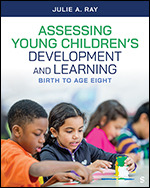Assessing Young Children’s Development and Learning
Birth to Age Eight
- Julie A. Ray - Southeast Missouri State University, USA
Other Titles in:
Early Childhood Assessment
Early Childhood Assessment
March 2026 | SAGE Publications, Inc
Assessing Young Children’s Development and Learning: Birth to Age Eight by Julie A. Ray helps early childhood educators understand both the need for assessment as well as the process of assessment for infants, toddlers, and children up to age eight. This comprehensive text covers a wide range of assessment strategies, from observation to formalized assessments, and further, shows students how to adapt these assessments for a wide variety of students and incorporate feedback from families. Built around the latest National Association for the Education of Young Children (NAEYC) standards from 2020, this text offers clear guidance to future educators for licensing requirements and to instructors for program accreditation. Each chapter opens with a vignette to demonstrate the importance of assessment for real classrooms. The chapters conclude with three case studies that apply the chapter's contents to each group of students: one for infants and toddlers, one for preschoolers, and one for primary-grade students. These case studies showcase each group's unique challenges and settings, providing additional instruction and assessment activities. The Appendix includes a final project and scoring rubric that could be used in course grading or to provide data for accreditation standards. Exercises and activities throughout help readers apply their knowledge, enabling them to confidently and competently assess students in a wide variety of early childhood educational settings.
Preface
Acknowledgments
About the Author
Chapter 1: Introduction to Developmentally Appropriate Assessment Practices
Chapter 2: Observation and Documentation: The Foundation of Assessment of Young Children
Chapter 3: Observation-Based Descriptive Assessment Methods
Chapter 4: Observation-Based Assessment Methods That Count or Rate
Chapter 5: Performance-Based Assessment Methods
Chapter 6: Informal Paper / Pencil Assessments for the Primary Grades
Chapter 7: Formal Standardized Assessments
Chapter 8: Using Portfolio Data to Plan Instruction
Chapter 9: Using Assessment Data to Support Development, Learning, and Program Improvement
Chapter 10: Using Assessments in Tiered Systems of Support
Chapter 11: Assessing Children with Developmental Delays or Disabilities
Chapter 12: Assessing Linguistically Diverse Children
Chapter 13: Families as Assessment Partners
Appendix A: Developmental Milestones
Appendix B
References

